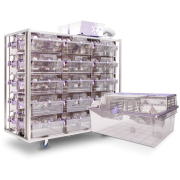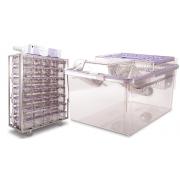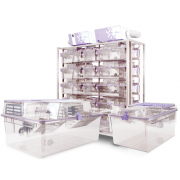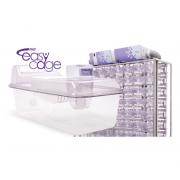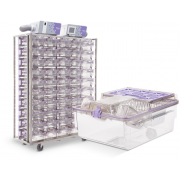Health Monitoring in IVC racks - SENTINEL
Science meets technology
Through collaboration with Allentown, Inc., the idea of merging EAD™ PCR testing with a unique sample capture unit was made possible. The Allentown Sentinel™ (see Figure 1) is an revolutionary new colony protection solution that can be easily integrated into Allentown IVC plenum chambers. It provides a more effective approach to pathogen screening of rodent animal colonies housed in IVCs, as well as reduced labor and costs associated with maintaining soiled-bedding sentinels. In cooperation with Allentown, Charles River conducted studies to demonstrate proof of performance for the Sentinel™. This process included a comparison of EAD™ PCR testing of the Sentinel™ with traditional, soiled-bedding detection methods for several infectious agents. The study results demonstrated the detection of agents by EAD PCR on the Sentinel™ that were poorly detected or undetected by soiled-bedding sentinels (Table below).
Benefits of Sentinel™ Testing with Charles River PCR
- Qualified PCR testing extraction processes designed specifically for the Sentinel™ unit
- Access to industry leaders in animal health surveillance and PCR diagnostic testing
- More sensitive and specific than soiled-bedding method
- Reduces the need for sentinel animals
Summary of agent groups detected via soiled-bedding method versus EAD™ PCR on the Sentinel™.
| Agent group | Soiled-Bedding method | Sentinel™ PCR Method |
| Protozoa | 10% positive | 100% positive |
| Mites & pinworms | 6,3% positive | 100% positive |
| Bacteria | 21,4% positive | 85,7% positive |
| Viruses | 31,3% positive | 100% positive |
| Average of all agents | 17,25% positive | 96,4% positive |
Note: Data represent 5% simulated prevalence.
Program overview
Once the Sentinel™ has been integrated into your Allentown rack, allow it to collect exhaust air dust for the duration of your regular health monitoring interval (e.g., 3 months). When it is time to test your rack, simply remove the Sentinel™ collection media, place it into a sample collection container and ship it to Charles River for testing. Sample submission can be scheduled in LTM™ (Laboratory Testing Management™), our online data management platform. Here, you will have the option of selecting EAD™ (Environmental) PRIA Panels that vary in level, from Prevalent to Complete; custom panels are available upon request. Our experts can help determine program frequency and ideal testing profiles. Example programs are outlined below.
| Program type - annual frequency | Month 3 | Month 6 | Month 9 | Month 12 |
| Sentinel-Free - Plenum level monitoring | ST | ST | ST | ST |
| Hybrid - Rack level monitoring | ST | S | ST | S |
ST= Exhaust Air Dust (EAD™) PCR testing on the Sentinel™ collection media*
S= Sentinel monitoring via traditional methods (i.e., serology, PCR, whole animal screening) performed on either resident
(immunocompetent only) or sentinel animals
*Non-invasive fecal samples can be collected from resident or sentinel rodents and pooled with EADTM samples

Program development
Not all laboratory animal facilities are the same and, quite often, require health monitoring (HM) programs that are specifically designed around an institution’s infectious agent exclusion list, study protocols or type of research animals being utilized. Charles River 360 Diagnostics™ experts will work directly with you to develop a customized HM program that meets your budgetary andsurveillance requirements. Program development can include:
- consultation to assess biosecurity risk
- step-by-step assessment of current HM processes
- preventative training and education
- facility design consultation

